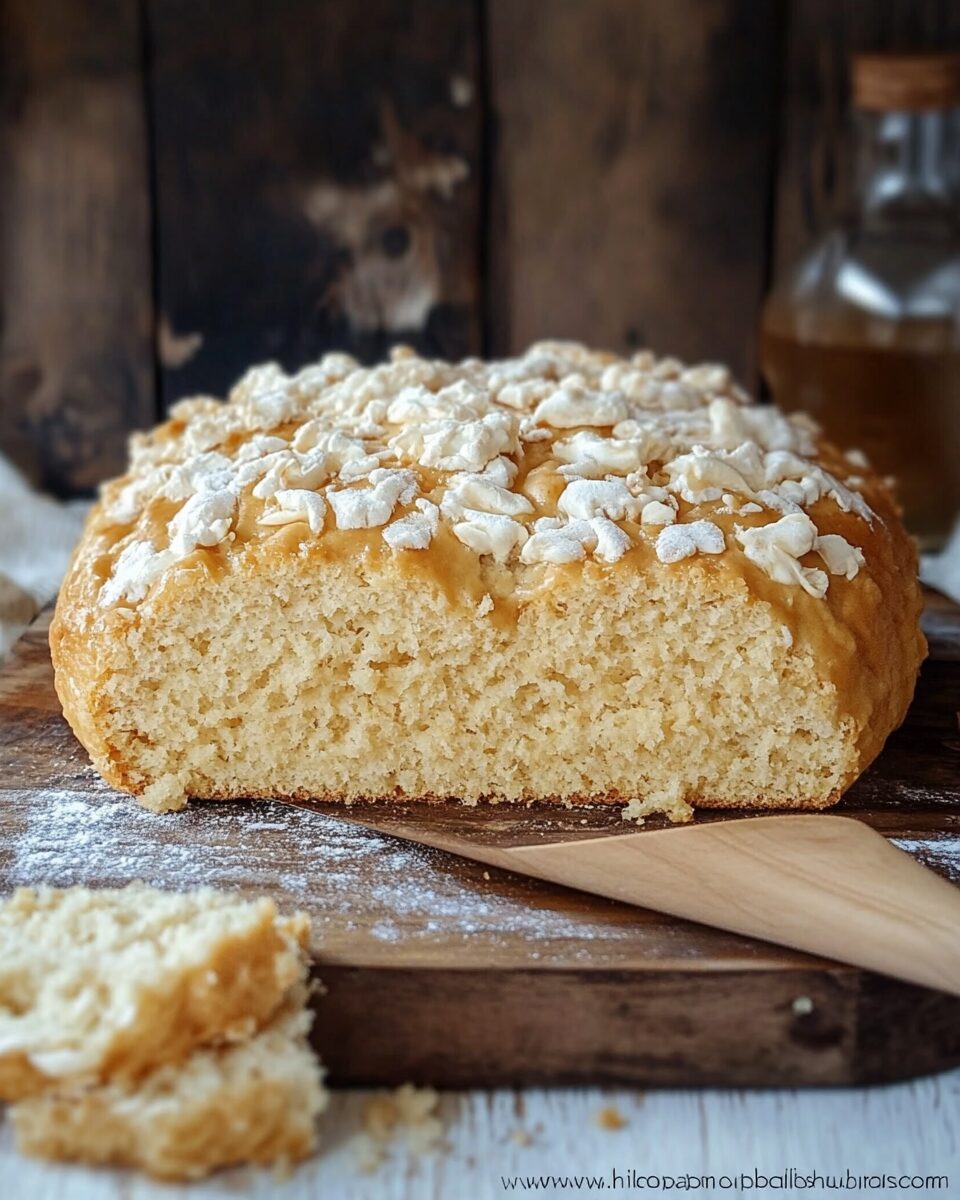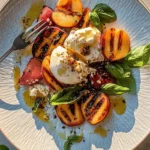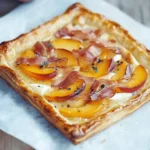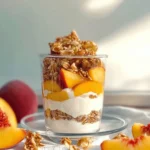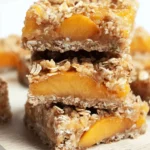Viking Bread is a dense, hearty loaf inspired by traditional recipes from the Viking Age. This bread provides a glimpse into the sustenance of Norse explorers, offering a rich, earthy flavor and substantial texture. Enjoy it warm, drizzled with honey, or as an accompaniment to soups and stews.
FULL RECIPE:
Ingredients
- 3 cups whole wheat flour
- 2 cups all-purpose flour
- 1 teaspoon baking soda
- 1 teaspoon salt
- 2 cups water
- 3/4 cup rolled oats
- 1/3 cup rolled oats (for sprinkling on top)
Directions
- In a large bowl, combine whole wheat flour, all-purpose flour, baking soda, salt, and 3/4 cup rolled oats.
- Add water to the dry ingredients, stirring with a wooden spoon until the mixture becomes too stiff to stir.
- With damp hands, knead the dough until all the flour is fully incorporated.
- Shape the dough into a round loaf and place it on a baking stone.
- Sprinkle the remaining 1/3 cup of rolled oats on top of the loaf.
- Place the baking stone with the dough into a cold oven.
- Set the oven to 375°F (190°C) and bake for 1 hour.
- After baking, remove the bread from the oven and let it cool slightly before serving.
Nutrients
- Calories: Approximately 411 kcal
- Carbohydrates: 85 g
- Protein: 12 g
- Fat: 2 g
- Saturated Fat: 1 g
- Sodium: 433 mg
- Potassium: 152 mg
- Fiber: 4 g
- Sugar: 1 g
- Calcium: 23 mg
- Iron: 5 mg
Historical Significance
The Viking Age, spanning from the late eighth century to the early eleventh century, was characterized by seafaring exploration, trade, and settlement. To sustain themselves during long voyages and harsh winters, Vikings relied on nutrient-dense foods like bread. Archaeological evidence suggests that the primary grains used in Viking bread-making were barley, rye, and oats. These grains were locally grown and resilient to the Scandinavian climate. Unlike modern wheat, these grains contained less gluten, resulting in a heavier loaf. Bread was often baked on flat stones or griddles over an open fire, and it was a crucial part of the Norse diet. Additionally, Viking Bread may have included seeds, nuts, or even honey to enhance its flavor and nutritional value. The simplicity of the recipe also reflects the resourcefulness of the Viking people, who made the most of their available ingredients.
The Simplicity and Hardiness of Viking Bread
One of the defining features of Viking Bread is its simple, whole-food ingredients. The bread was made using coarse-ground grains such as barley, rye, and whole wheat, which were more resistant to the cold climate of Scandinavia. Since refined flour was unavailable, Viking Bread had a dense, heavy texture with a slightly chewy consistency. Some versions included ground nuts, seeds, or herbs to enhance the flavor and nutritional content. The bread was often baked as flat rounds or small loaves and cooked in stone ovens, over open flames, or even buried under hot coals.
How Viking Bread Was Traditionally Enjoyed
Viking Bread was often eaten as a staple food alongside other traditional Norse dishes. It was commonly served with soups, stews, dried meats, fish, or fermented dairy products such as skyr (a type of Icelandic yogurt). Since butter and lard were widely available, they were often spread on the bread for added flavor and energy. Viking warriors on long voyages or raids would carry dried bread that could be softened in broth or ale, making it easier to eat and digest.
Nutritional Value and Health Benefits
Viking Bread is a nutritious choice, particularly when made using whole wheat flour and oats. Whole grains are rich in fiber, which promotes digestive health and helps maintain stable blood sugar levels. The bread’s high fiber content also supports heart health and provides a sustained source of energy. Additionally, whole grains contain essential vitamins and minerals, including iron, magnesium, and B vitamins. Oats contribute further nutritional benefits, offering antioxidants and beneficial plant compounds that may reduce inflammation and improve cholesterol levels. Viking Bread’s low fat content makes it a heart-healthy option, while its dense nature makes it filling and satisfying. It is also a suitable choice for those seeking a balanced and natural diet.
Serving Suggestions
Viking Bread pairs well with a variety of dishes, making it a versatile addition to any meal. Its dense texture and mild flavor make it an excellent accompaniment to soups and stews, particularly those with rich broths or creamy bases. For a traditional Viking-inspired experience, serve the bread alongside smoked or cured meats, pickled vegetables, and fermented dairy products like skyr or kefir. It can also be enjoyed with butter, honey, or jam for a simple yet satisfying snack. Additionally, Viking Bread can be used as a base for open-faced sandwiches, topped with cheese, fresh greens, and smoked fish. When sliced thinly, it can be toasted and paired with a hearty vegetable stew for a comforting meal. Its rustic appearance also makes it a charming addition to themed gatherings or historical reenactments.
Cultural Impact and Modern Adaptations
In recent years, there has been a resurgence of interest in historical cooking, with many people seeking to recreate authentic Viking dishes. Viking Bread has become a popular choice for those interested in exploring traditional Scandinavian cuisine. Modern adaptations often include additional ingredients, such as seeds, nuts, or dried fruits, to enhance flavor and nutritional value. While the traditional recipe calls for a simple blend of whole wheat flour, oats, and water, contemporary bakers may use rye flour or incorporate herbs for a unique twist. Some also experiment with adding honey or molasses to introduce a touch of sweetness. Despite these adaptations, the essence of Viking Bread remains rooted in its simplicity and practicality.
Conclusion
Viking Bread offers a fascinating journey into the culinary traditions of the Norse people. Its dense, hearty texture and earthy flavor provide a glimpse into a time when meals were crafted with resilience and resourcefulness. Beyond its historical significance, this bread serves as a nutritious and satisfying addition to any meal. Whether enjoyed with a bowl of stew, paired with cheese and cured meats, or topped with a drizzle of honey, Viking Bread brings a touch of ancient heritage to modern kitchens. Embracing the simplicity of this bread not only connects us to the past but also encourages mindful eating and appreciation for the nourishment that food provides. For those seeking an authentic culinary experience, Viking Bread is a timeless and rewarding choice that continues to resonate across generations.

